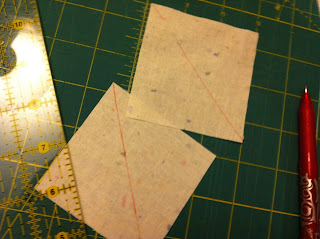 |
| Each background 3" square is marked on the diagonal. |
 |
| Half-square triangles are going to be stitched from a background square and a color square. Each combination will make 2 half-square triangles. |
 |
| This is a close-up showing the bright colors on the right and the confetti background on the left. |
 |
| The first seam is made a scant quarter-inch to the left of the marked diagonal line. |
 |
| Squares are chained together as the diagonals are sewn. |
 |
| The chained squares are then reversed for the next seam. |
 |
| The second seam is made on the opposite side of the diagonal, again a scant quarter-inch away from the marked line. |
 |
| After the seams are completed, the chain of squares is separated. |
 |
| Each set is now cut along the diagonal, leaving a pair of triangles. The triangles will be opened up to make squares. |
 |
| Squares to be cut apart on the left and yellow triangles on the right. |
 |
| Here's a pile of yellow and orange triangles ready for the next step. |
 |
| I've laid out the triangles on the ironing board. First the triangles are pressed to set the seam, and then they are opened up and the seam pressed away from the background fabric. |
 |
| Here's what they look like after the squares are pressed open. |
 |
| The yellow and orange half-square triangles (HST) were the last of the various colors to make. Here's a shot of the temporary storage box containing all the different colors for the quilt. |
 |
| This next step is vital - trimming the HSTs to the exact size needed. |
 |
| Using a 6" square tool, the first cut trims two sides of the square, making sure the diagonals are lined up. |
 |
| After taking the newly cut edges and lining them up on the 2 1/2 inch marks, the other sides are trimmed. |
 |
| This shows the perfect HST under the tool and the excess fabric that has been cut away. |

No comments:
Post a Comment